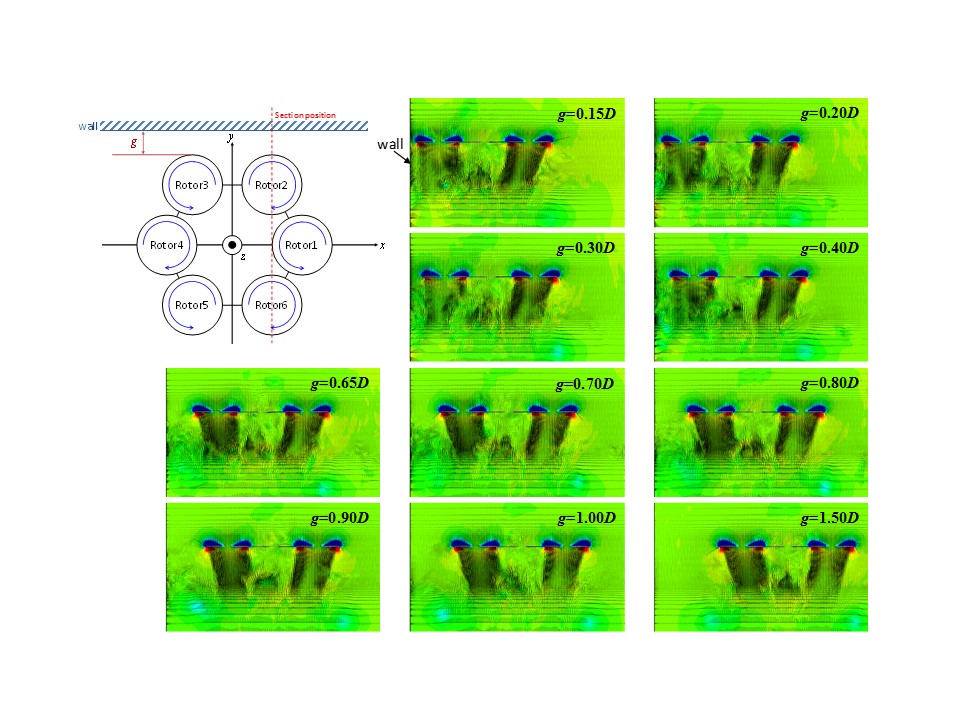CFD Analysis of a Multiple Rotor UAV near Walls
JAXA Supercomputer System Annual Report April 2017-March 2018
Report Number: R17ECMP17
Subject Category: Competitive Funding
- Responsible Representative: Yasutada Tanabe, Aeronautical Technology Directorate, Next Generation Aeronautical Innovation Hub Center
- Contact Information: Yasutada Tanabe tanabe.yasutada@jaxa.jp
- Members: Yasutada Tanabe, Hideaki Sugawara
Abstract
Represented by the multiple rotor type UAV (Unmanned Aerial Vehicle), or so-called drone, the flying robot has been applied to disaster relief and other operations. However, the wind and gust resistence of this type of drone need to be further improved. Especially in the observation and survey of existing infrastructures, buidings and bridges, the drones are often required to fly near walls. The flowfields around the drones are significantly changed with walls nearby and highly depend on the distance between the drone and the walls. It is considered very effective to incorporate the wall influence on the flight performance into the flying control rules.
This research is carried out as a part of the Tough Robotics Challenge funded by the ImPACT Program of Council for Science, Technology and Innovation (Cabinet Office, Government of Japan). The influence of an upper wall and a side wall on the aerodynamics of the multiple rotors is investigated through CFD simulations. Also the flight performance of a drone inside narrow tunnels is under studies.
Reference URL
Please refer to ‘Impulsing Paradigm Change through Disruptive Technologies Program ImPACT: R&D Programs‘.
Reasons for using JSS2
Numerical simulations of multiple rotors are carried out using a CFD code, rFlow3D, developed at JAXA. The rotor blades are modeled with high fidelity. A large amount of flight conditions must be considered and each takes a long time of CPU hours. JSS2 supercomputer is a prerequisite of this kind of research.
Achievements of the Year
A hexa-rotor drone hovering near an upper wall (ceiling) and a side wall is numerically simulated. When the distance between the drone and the wall because shorter than 1.5 times of the rotor diameter, the aerodynamic forces generated by the rotors changes remarkably. The flight performance of a drone flying inside narrow tunnels is also investigated.

Fig.1: Changes of the flowfields around a hexa-rotor drone due to distance changes between the drone and a side wall
Publications
■ Non peer-reviewed papers
1) Koichi Yonezawa, Hironori Matsumoto, Kazuyasu Sugiyama, Hiroshi Tokutake, Yasutada Tanabe, Shigeru Sunada, “Development of High-Performance Multi-Rotor Drone”, Fourteenth International Conference on Flow Dynamics, November 1-3, 2017, Sendai International Center.
2) Yasutada Tanabe, Masahiko Sugiura, Takashi Aoyama, Hideaki Sugawara, Shigeru Sunada, Koichi Yonezawa, Hiroshi Tokutake, “Influences of Upper and Side Walls on the Performance of a Multiple Rotor Drone”, 6th Asian-Australian Rotorcraft Forum & Heli Japan 2017, November 7-9, 2017, Kanazawa, Japan.
3) Koichi Yonezawa, Hironori Matsumoto, Kazuyasu Sugiyama, Hiroshi Tokutake, Yasutada Tanabe, Shigeru Sunada, “Development of a Ducted Rotor for Multicopters”, 6th Asian-Australian Rotorcraft Forum & Heli Japan 2017, November 7-9, 2017, Kanazawa, Japan.
4) Raijo Torita, Takuji Kishi, Hiroshi Tokutake, Shigeru Sunada, Yasutada Tanabe, Koichi Yonezawa, “Modeling of Aerodynamic Characteristics of Drone and Improvement of Gust Response”, 6th Asian-Australian Rotorcraft Forum & Heli Japan 2017, November 7-9, 2017, Kanazawa, Japan.
Usage of JSS2
Computational Information
- Process Parallelization Methods: N/A
- Thread Parallelization Methods: OpenMP
- Number of Processes: 1
- Elapsed Time per Case: 720.00 hours
Resources Used
Fraction of Usage in Total Resources*1(%): 0.22
Details
Please refer to System Configuration of JSS2 for the system configuration and major specifications of JSS2.
| System Name | Amount of Core Time(core x hours) | Fraction of Usage*2(%) |
|---|---|---|
| SORA-MA | 570,860.89 | 0.08 |
| SORA-PP | 232,987.32 | 2.92 |
| SORA-LM | 0.00 | 0.00 |
| SORA-TPP | 0.00 | 0.00 |
| File System Name | Storage Assigned(GiB) | Fraction of Usage*2(%) |
|---|---|---|
| /home | 060.80 | 0.04 |
| /data | 3,662.11 | 0.07 |
| /ltmp | 488.28 | 0.04 |
| Archiver Name | Storage Used(TiB) | Fraction of Usage*2(%) |
|---|---|---|
| J-SPACE | 0.00 | 0.00 |
*1: Fraction of Usage in Total Resources: Weighted average of three resource types (Computing, File System, and Archiver).
*2: Fraction of Usage:Percentage of usage relative to each resource used in one year.
JAXA Supercomputer System Annual Report April 2017-March 2018


